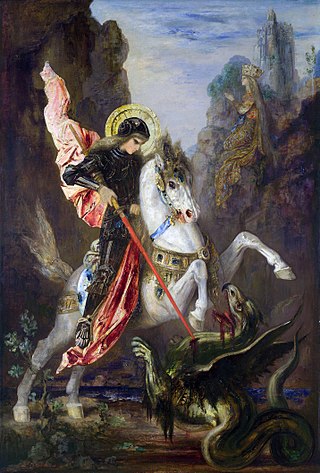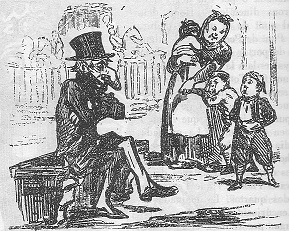Related Research Articles

Christian mythology is the body of myths associated with Christianity. The term encompasses a broad variety of legends and narratives, especially those considered sacred narratives. Mythological themes and elements occur throughout Christian literature, including recurring myths such as ascending a mountain, the axis mundi, myths of combat, descent into the Underworld, accounts of a dying-and-rising god, a flood myth, stories about the founding of a tribe or city, and myths about great heroes of the past, paradises, and self-sacrifice.
Bölþorn is a jötunn in Norse mythology, and the father of Bestla, herself the mother of Odin, Vili and Vé.
Baugi is a jötunn in Norse mythology. He is brother of Suttungr, the giant from whom Odin obtained the mead of poetry.

The European dragon is a legendary creature in folklore and mythology among the overlapping cultures of Europe.
In Australian Aboriginal mythology, Mokoi is an evil spirit who killed sorcerers who used black magic. Also known to kidnap children at night to eat them. The Murngin believed that death was rarely caused by old age and instead it was the work of a mokoi, who would bring about some sort of disease or fatal accident. The legend say he gave his life for the devil. He’s in his debt and he’s helping him. His main task is to kill magicians who take pleasure in black magic. He does this because the magicians take a pact and it leads to death. He eats the children to extract their elixir of life. He needs the elixir to strengthen himself, which is paradoxical because he’s dead. Another thesis is, that he kills the children to lure the parents into the woods to inflict them harm.
Whiro-te-tipua is the lord of darkness and embodiment of all evil in Māori mythology. He inhabits the underworld and is responsible for the ills of all people, a contrast to his brother and enemy Tāne.

Catalan myths and legends are the traditional myths and legends of the Catalan-speaking world, especially Catalonia itself, passed down for generations as part of that region's popular culture.

'Likho, liho, lykho is an embodiment of evil fate and misfortune in Slavic mythology, a creature with one eye, often depicted as an old, skinny woman in black or as an evil male goblin of forests. Rather than being included in the major canon of the Slavic belief system, the Likho is traditionally found in fairy tales.
The Muldjewangk is a water-creature in Ngarrindjeri mythology that inhabited the Murray River, particularly Lake Alexandrina. It was used as a deterrent for Aboriginal children who wished to play near the riverside after dark. Sometimes they are portrayed as evil merfolk, and other times as a gargantuan monster. Accounts are inconsistent as to whether there are many of the creatures, or a single "The Muldjewangk".

Erlik, Erlig, Erlik Khan, Erleg or Yerleg is the god of death and the underworld, sometimes referred to as Tamag (hell) in Turkic mythology. Er means Earth, in the depths of which Erlik lives in. From the underworld, Erlik brings forth death, plague and evil spirits to torment humans and take their souls into his realm. Since Tengrism is not based on a written corpus but encompasses the experienced spiritual life of Turkic people, there are no unanimous beliefs among all Turkic people. Erlik has already been mentioned in the Orkhon writings and shows a consistent pattern as the lord of the underworld among Turkic belief systems.
In Japanese mythology and fantasy, mazoku (魔族) are supernatural beings, normally evil ones such as devils or demons. A maō (魔王) or maou is a ruler of mazoku, or in fiction more generically a dark lord or powerful monster.

Ördög is a shape-shifting, demonic creature from Hungarian mythology and early Hungarian paganism who controls the dark and evil forces of the world. After Christianization, it was identified with the devil. It is often said in Hungarian mythology that God had help from Ördög when creating the world.

Yōsei is a Japanese word that is generally synonymous with the English term fairy (フェアリー). Today, this word usually refers to spirits from Western legends, but occasionally it may also denote a creature from native Japanese folklore. For example, according to an old folk belief from Iwate Prefecture, it was once feared that the yōsei could resurrect the dead. It is also mentioned that the people of Mt. Hōrai are small fairies that have no knowledge of great evil and so their hearts never grow old. The Ainu also tell of a race of small people known as the Koro-pok-guru in their folklore. Another fairy-like being from Japan is the Kijimuna, tree sprites told in the Ryukyuan religion of Okinawa.
Richard Cavendish was a British historian who was considered Britain's foremost authority on the subjects of occultism, religion, the tarot, and mythology.
The Vainakh peoples of the North Caucasus were Islamised comparatively late, during the early modern period, and Amjad Jaimoukha (2005) proposes to reconstruct some of the elements of their pre-Islamic religion and mythology, including traces of ancestor worship and funerary cults. The Nakh peoples, like many other peoples of the North Caucasus such as Circassians and Ossetians, practised tree worship, and believed that trees were the abodes of spirits. Vainakh peoples developed many rituals to serve particular kinds of trees. The pear tree held a special place in the faith of Vainakhs.
In Australian Aboriginal mythology, Kinie Ger is an evil half-man, half-quoll beast that hunts and kills the innocent with his spear, until he is himself killed in an ambush.
Thinan-malkia is an evil spirit in Australian Aboriginal mythology that captures victims with nets that entangle their feet.

Guayota, in Guanche mythology of Tenerife, was the principal malignant deity and Achamán's adversary.
References
- ↑ Massola, Aldo (1968). Bunjil's cave: myths, legends and superstitions of the aborigines of south-east Australia. Lansdowne Press. p. 150. Retrieved 15 May 2013.
Mercatante, Anthony S.. "Wambeen."The facts On File Encyclopedia of world Mythology and Legend. 1988.
